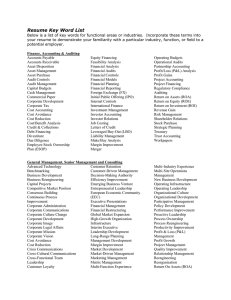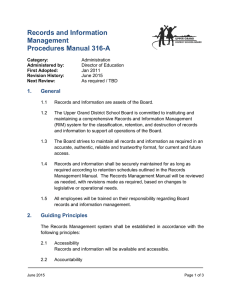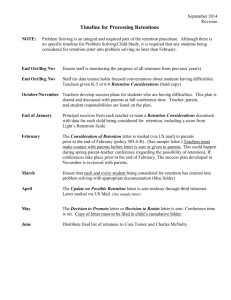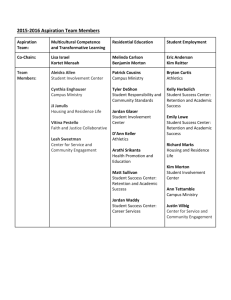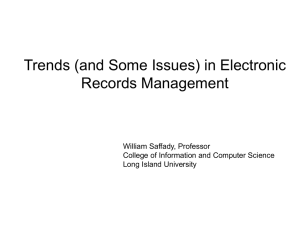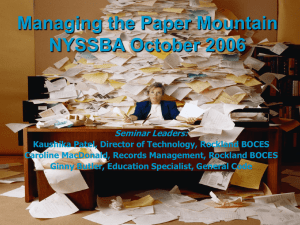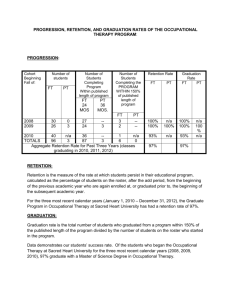Relationship Marketing.
advertisement
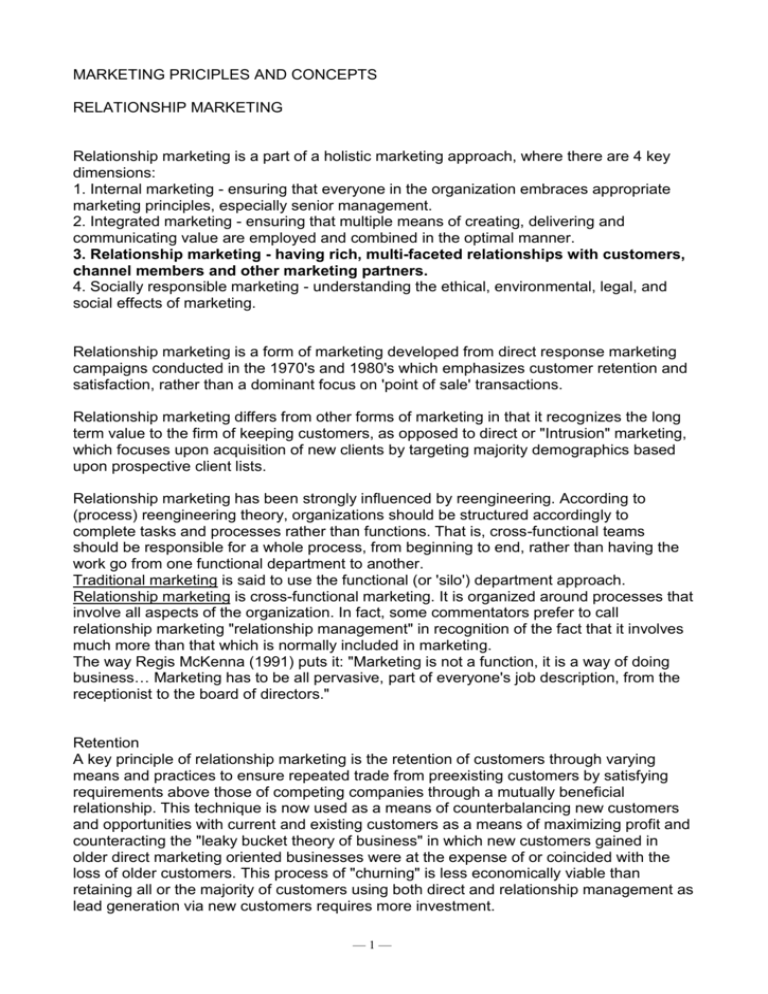
MARKETING PRICIPLES AND CONCEPTS RELATIONSHIP MARKETING Relationship marketing is a part of a holistic marketing approach, where there are 4 key dimensions: 1. Internal marketing - ensuring that everyone in the organization embraces appropriate marketing principles, especially senior management. 2. Integrated marketing - ensuring that multiple means of creating, delivering and communicating value are employed and combined in the optimal manner. 3. Relationship marketing - having rich, multi-faceted relationships with customers, channel members and other marketing partners. 4. Socially responsible marketing - understanding the ethical, environmental, legal, and social effects of marketing. Relationship marketing is a form of marketing developed from direct response marketing campaigns conducted in the 1970's and 1980's which emphasizes customer retention and satisfaction, rather than a dominant focus on 'point of sale' transactions. Relationship marketing differs from other forms of marketing in that it recognizes the long term value to the firm of keeping customers, as opposed to direct or "Intrusion" marketing, which focuses upon acquisition of new clients by targeting majority demographics based upon prospective client lists. Relationship marketing has been strongly influenced by reengineering. According to (process) reengineering theory, organizations should be structured accordingly to complete tasks and processes rather than functions. That is, cross-functional teams should be responsible for a whole process, from beginning to end, rather than having the work go from one functional department to another. Traditional marketing is said to use the functional (or 'silo') department approach. Relationship marketing is cross-functional marketing. It is organized around processes that involve all aspects of the organization. In fact, some commentators prefer to call relationship marketing "relationship management" in recognition of the fact that it involves much more than that which is normally included in marketing. The way Regis McKenna (1991) puts it: "Marketing is not a function, it is a way of doing business… Marketing has to be all pervasive, part of everyone's job description, from the receptionist to the board of directors." Retention A key principle of relationship marketing is the retention of customers through varying means and practices to ensure repeated trade from preexisting customers by satisfying requirements above those of competing companies through a mutually beneficial relationship. This technique is now used as a means of counterbalancing new customers and opportunities with current and existing customers as a means of maximizing profit and counteracting the "leaky bucket theory of business" in which new customers gained in older direct marketing oriented businesses were at the expense of or coincided with the loss of older customers. This process of "churning" is less economically viable than retaining all or the majority of customers using both direct and relationship management as lead generation via new customers requires more investment. —1— According to Buchanan and Gilles [11], the increased profitability associated with customer retention efforts occurs because of several factors that occur once a relationship has been established with a customer. - The cost of acquisition occurs only at the beginning of a relationship, so the longer the relationship, the lower the amortized cost. - Account maintenance costs decline as a percentage of total costs (or as a percentage of revenue). - Long-term customers tend to be less inclined to switch, and also tend to be less price sensitive. This can result in stable unit sales volume and increases in dollar-sales volume. - Long-term customers may initiate free word of mouth promotions and referrals. - Long-term customers are more likely to purchase ancillary products and high margin supplemental products. - Customers that stay with you tend to be satisfied with the relationship and are less likely to switch to competitors, making it difficult for competitors to enter the market or gain market share. - Regular customers tend to be less expensive to service because they are familiar with the process, require less "education", and are consistent in their order placement. - Increased customer retention and loyalty makes the employees' jobs easier and more satisfying. In turn, happy employees feed back into better customer satisfaction in a virtuous circle. Retention strategies also build barriers to customer switching. This can be done by product bundling (combining several products or services into one "package" and offering them at a single price), cross selling (selling related products to current customers), cross promotions (giving discounts or other promotional incentives to purchasers of related products), loyalty programs (giving incentives for frequent purchases), increasing switching costs (adding termination costs, such as mortgage termination fees), and integrating computer systems of multiple organizations (primarily in industrial marketing). Many relationship marketers use a team-based approach. The rationale is that the more points of contact between the organization and customer, the stronger will be the bond, and the more secure the relationship. Relationship marketing and traditional (or transactional) marketing are not mutually exclusive and there is no need for a conflict between them. Most firms blend the two approaches to match their portfolio of products and services. (Adrian Payne (1991) from Cranfield University goes further. He identifies six markets, which he claims are central to relationship marketing. They are: internal markets, supplier markets, recruitment markets, referral markets, influence markets, and customer markets. Each market may require its own explicit strategies and separate marketing mixes for each). —2—



